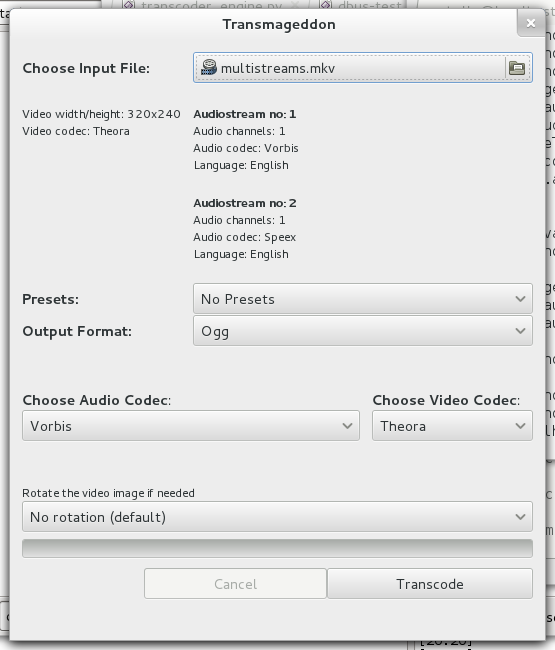One feature that would be of interest to us in the Empathy Video Conference client is the ability to record conversations. Due to that I have been putting together a simple prototype Python test application in free moments to verify that everything works as expected, before any effort is put into doing any work inside Empathy.
The sample code below requires two webcams to be connected to your system to work. It basically takes the two camera video streams, puts one of them through a encode/rtp/decode process (to roughly emulate what happens in a video call) and puts a text overlay onto the video to let the conference participant know the call is being recorded. The two video streams are then mixed together and displayed. In the actual application the combined stream would be saved to disk instead of course and also audio captured and mixed.
If we ever get around to working on this feature is an open question, but at least we can now assume that it is likely to work. Of course getting one stream in over the network over RTP is very different from what this sample does, so that might uncover some bugs.
The sample also works with Python3, so even though it is only a prototype it already fulfils the GNOME Goal :)
import sys
from gi.repository import Gst
from gi.repository import GObject
GObject.threads_init()
Gst.init(None)
import os
class VideoBox():
def __init__(self):
mainloop = GObject.MainLoop()
# Create transcoding pipeline
self.pipeline = Gst.Pipeline()
self.v4lsrc1 = Gst.ElementFactory.make('v4l2src', None)
self.v4lsrc1.set_property("device", "/dev/video0")
self.pipeline.add(self.v4lsrc1)
self.v4lsrc2 = Gst.ElementFactory.make('v4l2src', None)
self.v4lsrc2.set_property("device", "/dev/video1")
self.pipeline.add(self.v4lsrc2)
camera1caps = Gst.Caps.from_string("video/x-raw, width=320,height=240")
self.camerafilter1 = Gst.ElementFactory.make("capsfilter", "filter1")
self.camerafilter1.set_property("caps", camera1caps)
self.pipeline.add(self.camerafilter1)
self.videoenc = Gst.ElementFactory.make("theoraenc", None)
self.pipeline.add(self.videoenc)
self.videodec = Gst.ElementFactory.make("theoradec", None)
self.pipeline.add(self.videodec)
self.videortppay = Gst.ElementFactory.make("rtptheorapay", None)
self.pipeline.add(self.videortppay)
self.videortpdepay = Gst.ElementFactory.make("rtptheoradepay", None)
self.pipeline.add(self.videortpdepay)
self.textoverlay = Gst.ElementFactory.make("textoverlay", None)
self.textoverlay.set_property("text","Talk is being recorded")
self.pipeline.add(self.textoverlay)
camera2caps = Gst.Caps.from_string("video/x-raw, width=320,height=240")
self.camerafilter2 = Gst.ElementFactory.make("capsfilter", "filter2")
self.camerafilter2.set_property("caps", camera2caps)
self.pipeline.add(self.camerafilter2)
self.videomixer = Gst.ElementFactory.make('videomixer', None)
self.pipeline.add(self.videomixer)
self.videobox1 = Gst.ElementFactory.make('videobox', None)
self.videobox1.set_property("border-alpha",0)
self.videobox1.set_property("top",0)
self.videobox1.set_property("left",-320)
self.pipeline.add(self.videobox1)
self.videoformatconverter1 = Gst.ElementFactory.make('videoconvert', None)
self.pipeline.add(self.videoformatconverter1)
self.videoformatconverter2 = Gst.ElementFactory.make('videoconvert', None)
self.pipeline.add(self.videoformatconverter2)
self.videoformatconverter3 = Gst.ElementFactory.make('videoconvert', None)
self.pipeline.add(self.videoformatconverter3)
self.videoformatconverter4 = Gst.ElementFactory.make('videoconvert', None)
self.pipeline.add(self.videoformatconverter4)
self.xvimagesink = Gst.ElementFactory.make('xvimagesink',None)
self.pipeline.add(self.xvimagesink)
self.v4lsrc1.link(self.camerafilter1)
self.camerafilter1.link(self.videoformatconverter1)
self.videoformatconverter1.link(self.textoverlay)
self.textoverlay.link(self.videobox1)
self.videobox1.link(self.videomixer)
self.v4lsrc2.link(self.camerafilter2)
self.camerafilter2.link(self.videoformatconverter2)
self.videoformatconverter2.link(self.videoenc)
self.videoenc.link(self.videortppay)
self.videortppay.link(self.videortpdepay)
self.videortpdepay.link(self.videodec)
self.videodec.link(self.videoformatconverter3)
self.videoformatconverter3.link(self.videomixer)
self.videomixer.link(self.videoformatconverter4)
self.videoformatconverter4.link(self.xvimagesink)
self.pipeline.set_state(Gst.State.PLAYING)
mainloop.run()
if __name__ == "__main__":
app = VideoBox()
signal.signal(signal.SIGINT, signal.SIG_DFL)
exit_status = app.run(sys.argv)
sys.exit(exit_status)

